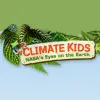Take a look inside 5 images
Climate Kids
Pros: This fun, fact-filled website invites students to explore and play while maintaining great depth in its content.
Cons: Text-heavy information is often organized several layers deep; finding specific answers to climate questions can be challenging.
Bottom Line: A great launching point for engaging in accurate and timely climate change information.
Teachers can use Climate Kids as a toolbox for learning about global climate change. Exploring the Big Questions section could help build essential background information before teachers dig deeper. Teachers can have students try games such as Offset to make learning about the carbon cycle more engaging. These games could be flipped for playing at home, with follow-up discussions taking place at school. Videos such as "What Is Happening in the Ocean" can spark whole-class discussions. The Activities page is full of resources and links that teachers may find useful for planning lessons.
Climate Kids is a comprehensive website from NASA covering a variety of global climate change topics. The website provides many ways to engage in learning, including games, hands-on activities, facts, videos, and career profiles. The site is organized into categories such as Atmosphere, Water, Weather & Climate, Plants & Animals, and Energy. The Big Questions section introduces students to the basics and provides answers to "What is global climate change?" and "What can we do to help?" The information is often text-heavy, and no audio support is offered. A page is dedicated to teaching about climate change and includes links to other websites; some of these links no longer work.
The Climate Change Time Machine is a standout interactive feature of the site that feeds the scientific inquiry process. Users can go backward and forward through time to visually see evidence of how Earth has changed over the years. The Time Machine includes maps of sea ice, sea level, carbon emissions, and average global temperature.
Climate Kids is an excellent learning tool for students because it provides accurate scientific information using a variety of media (games, videos, and interactives) that touch on the same topics. Offering multiple ways to access this critical information reaches a diverse set of students and provides opportunities for deeper learning. The website is colorful and well designed, but some students may struggle with the text-heavy articles. The site would be even more useful if information were easier to find and it provided audio support, translations, and other accessibility features.















